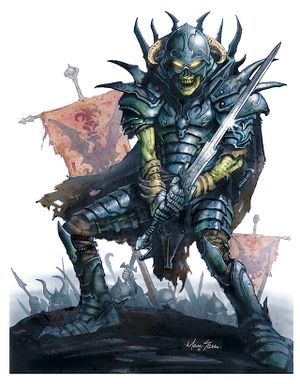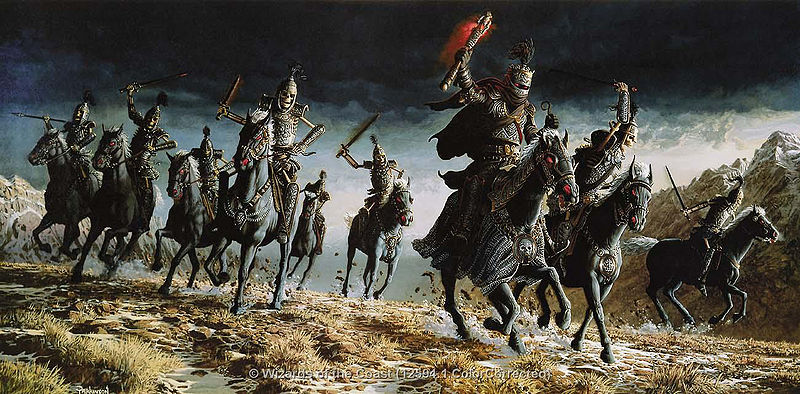Рыцарь смерти
Рыцарь смерти (англ. death knight) — вид нежити в Dungeons & Dragons и ряде других ролевых игр в жанре фэнтези. Представляет собой могущественного воина, служащего злу после смерти. В некоторых источниках носит название «рыцаря погибели» (doom knight) или «демонического рыцаря» (demon knight).
Содержание
История публикаций в D&D

Рыцарь смерти — «детище» Чарльза Стросса, создавшего этого монстра для дополнения к первой редакции AD&D «Fiend Folio» (1981 год). В обзоре в журнале «White Dwarf» Джейми Томпсон (Jamie Thompson) назвал рыцаря смерти одним из самых интересных добавлений, введённых этой книгой[1].
Наиболее широкую известность рыцарь смерти приобрёл в сеттинге Dragonlance, где Маргарет Уэйс и Трейси Хикмен создали образ Лорена Сота, ставшего одним из главных злодеев. Поэтому в рамках второй редакции AD&D рыцарь смерти впервые появился в «Monstrous Compendium Dragonlance Appendix» (1990 год), откуда был перепечатан в «Monstrous Manual» (1993 год). Более развёрнутое описание рыцарей смерти Кринна было помещено в буклете «World Book of Ansalon», входящем в коробку «Tales of the Lance» (1992 год). Рыцарь смерти также играет значительную роль в модуле «Apocalypse Stone» (2000 год), одном из последних продуктов по второй редакции.
В третьей редакции D&D рыцарь смерти впервые появился в выпущенной Necromancer Games книге «Tome of Horrors» и в статье Гэри Холиана «The Death Knights of Oerth» в журнале «Dragon» (№ 290 и 291). Только после этого рыцарь смерти был помещён в «Monster Manual II» (2002 год). Рыцарь смерти также нередко включался в книги, выпускаемые по OGL. В «Slayer’s Guide to Undead» (Mongoose Publishing, 2002 год) он описывается в разделе, посвящённом личам. Подробное описание рыцаря смерти также имеется в «Secret College of Necromancy» (Green Ronin, 2002 год). Статья «The Ecology of the Death Knight» в «Dragon» № 360 (октябрь 2007 года) даёт пересмотренное под D&D 3.5 описание рыцаря смерти. Также рыцари смерти включены в новое издание Dragonlance — «Dragonlance Campaign Setting» (2003 год).
В четвёртой редакции рыцарь смерти появился ещё до выхода рулбуков, в презентационных материалах (статья Мэтью Сёрнетта «The Ecology of the Death Knight» на сайте WotC[2] и книга «Wizards Presents: Worlds and Monsters» (2008 год). В базовых книгах новой редакции рыцарь смерти вошёл в первый «Monster Manual» (2008 год), где представлены две его разновидности: человек-воин (death knight human fighter) и драконорождённый-паладин (death knight dragonborn paladin).
Появление в других играх
Появившийся в «Fiend Folio» рыцарь смерти привлёк большое внимание других игроделов. Так, он появился в приложениях серии «Role-Aids», выпускавшихся Mayfair Games, в том числе в «Lich Lords» 1985 года[3], где описывается рыцарь смерти Теодрос (Theodros), играющий стереотипную роль командующего армией на службе могущественного лича.
Дополнение для игры Big Eyes, Small Mouth от Guardians of Order под названием «Cold Hands, Dark Hearts» (2003 год) описывает скелетного воина, архетип которого соответствует рыцарю смерти из «Fiend Folio»[4]. Это существо является падшим воителем веры, ныне служащим одному из повелителей демонов.
Рыцари смерти как игровые персонажи встречаются также в MMORPG, например в World of Warcraft: Wrath of the Lich King[5] и в DragonFable[6].
Описание
Death knights are usually created by demon lords or evil deities. These evil undead warriors are most commonly raised from the ranks of blackguards, fighters, rangers, and barbarians, but a paladin who falls from grace near the moment of death may also become a death knight. Paladins who become death knights are subject to the same modifications as are presented for the blackguard in Chapter 2 of the Dungeons and Dragons Dungeon Master's Guide.
In Dungeons & Dragons 3rd Edition (and Version 3.5), a death knight has an aura of fear that will rout groups of low-level enemies, can channel powerful negative energy with a touch, and the ability to project explosions of fire and unholy energy. [7]
The original Dungeons and Dragons Fiend Folio indicates that death knights are «lich-like». A death knight’s physical form is that of its decayed body. The face is a blackened skull with patches of rotting flesh with two pinpoints of orange light in the eye sockets. The voice of a death knight is chilling, seeming to echo from deep within. Death knights were powerful people in life, and so they often wear expensive or magic clothing and armor. They are fond of wearing flowing capes to mark them as figures of importance.
Death knights are (nearly) always evil.
Though death knights rarely work with their own kind, they often have a variety of undead servants such as skeleton warriors, liches, and banshees. Death knights often ride nightmares into battle. Given the nature of their creation they are also often in the service of some demon lord or god of evil.
В различных сеттингах
Dragonlance
The most famous of all death knights is Lord Soth, a disgraced Knight of Solamnia, from the Dragonlance and Ravenloft campaign settings. Loren Soth was cursed after he murdered his wife and child and failed to prevent the Cataclysm. He is attended by the skeleton warriors of his fallen troops and a cadre of ghostly banshees.
Soth is the most published Death Knight and is featured in all three editions of the Dungeons & Dragons game,[8] the New York Times best selling Dragonlance Chronicles[9] and Dragonlance Legends Trilogies, other novels of the Dragonlance mythos and outside of it, and various computer games.[10]
Forgotten Realms
A similar type of undead warrior was seen in the Forgotten Realms campaign setting. A paladin by the name of Miltiades was condemned by Tyr to exist as an undead knight for using dishonorable assassination tactics to kill his enemy Zarl. Miltiades retained his sense of good and fought by the sides of good heroes, helping to defeat the forces of Bane. He was eventually restored to life by Tyr after helping the heroes destroy a pool of darkness and a pool of twilight.
While Miltiades possessed an enchanted sword and armor, he did not have the ability to cast the magical spells mentioned above. He did still retain his «normal» paladin abilities like curing and turning the undead.
Shan Nikkoleth, a Death Knight of otherworldly origin, used to reside in Hellgate Keep (The Savage Frontier, page 42) but was blasted when the keep was destroyed.
An unnamed death knight, dressed like a vampire, also resides in Zhengyi's citadel (the Witch King of Vaasa) as described in module H4 «The Throne of Bloodstone». In that same adventure, an additional twelve death knights are also stated as dwelling in a city of liches in Orcus' realm.
Greyhawk
The first death knight identified by name in a Dungeons & Dragons product was Saint Kargoth, "King of the Death Knights, " who first appeared in Scott Bennie’s Dragon article, «Setting Saintly Standards» in 1983.
Kargoth appears in the World of Greyhawk campaign setting. Thirteen of Kargoth’s fellow and contemporary Knight Protectors of the Great Kingdom join him in becoming death knights: Lord Monduiz Dephaar, Lady Lorana Kath of Naelex, Prince Myrhal of Rax, Sir Maeril of Naelax, Sir Farian of Lirtham (destroyed 209 CY, but soul now powers the deathblade Astrosus), Lord Andromansis of Garasteth, Sir Oslan Knarren, Sir Rezinar of Haxx, Lord Thyrian of Naelax, Sir Minar Syrric of Darmen, Duke Urkar Grasz of Torquann, Sir Luren the Boar of Torquann, and Lord Khayven of Rax. All are transformed by the power of the demon prince Demogorgon.
Four other death knights of Oerth are known by name. The first is Saint Ferrante, a fallen paladin of Heironeous. The second is Sir Loran of Trollpyre Keep, a former knight of Sunndi. The third death knight’s real name is unknown, but he calls himself, Kas the Bloody-Handed. Oerth’s newest death knight is Vanthus Vanderboren, a former nobleman of Sasserine and servant of Demogorgon. Sainte Ferrante appears in Bastion of Faith,[11] while Loran and «Kas» appear in Die Vecna Die! as servants of Vecna. Other death knights also appear in the later adventure but are not identified by name. Vanthus Vanderboren appears in the Dungeon magazine’s Savage Tide adventure path, but he does not become a death knight until late in the campaign.
Примечания
- ↑ Thomson, Jamie (Dec/Jan 1981/1982). «Open Box» (review). White Dwarf (28): 14.
- ↑ Semett, Matthew The Ecology of the Death Knight (Preview). Wizards of the Coast (2007-10-03). Проверено 10 января 2008.
- ↑ Sellers, Lynn (1985). Lich Lords (1st ed.). Chicago, IL: Mayfair Games Inc.. pp. 36. ISBN 091277133X.
- ↑ Okum, David (2005). Cold Hands, Dark Hearts (1st ed.). Guardians of Order. pp. 96. ISBN 1894525531.
- ↑ Wrath of the Lich King - Official Site.
- ↑ April 23, 2008 Design Notes. Проверено 9 июля 2008.
- ↑
Рыцарь смерти Год 2002 ISBN 0-7869-2873-5 - ↑ Шаблон:Citation
- ↑ Шаблон:Citation
- ↑ Шаблон:Citation
- ↑
Рыцарь смерти Год 1999 ISBN 0786914424
